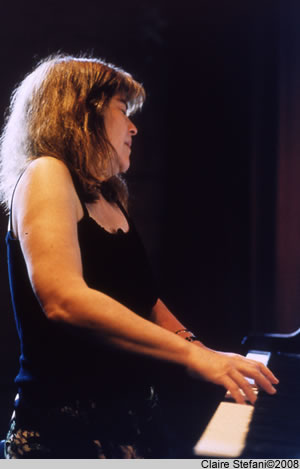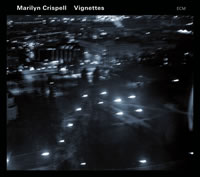Moment's Notice
Recent CDs Briefly Reviewed

Marilyn Crispell
Vignettes
ECM CD: B0010816-02

Marilyn Crispell’s development has been one of the more arresting narratives in the music of the past 25 years, from her extended work with Anthony Braxton, Reggie Workman and Joelle Leandre to a host of more ad hoc meetings. Along the way there have been striking solo recordings, going back to 1983 for Rhythms Hung in Undrawn Sky (Leo) and including the limpidly beautiful recordings of some Coltrane tunes as well as the works of a few compatible contemporary composers.
What’s perhaps most remarkable is the extent to which she has addressed – whether simultaneously or sequentially – dichotomies, collisions and disconnections in jazz piano styles. The dominant approaches that emerged around 1960 aren’t simply styles but mutually opposed harmonic systems, from the pan-tonality of Cecil Taylor to the modal/scalar patterns of McCoy Tyner (Coltrane’s pianistic proxy) to the extreme chromaticism and elusive triadic harmony of Bill Evans and the floating lyricism of Paul Bley. Different parts of that tapestry have revealed themselves at different times in the way Crispell puts her music together, but there’s a definite shift from the 1980s and the Taylor/ Coltrane models – highly divergent in themselves – to the harmonic density of the live Mills College and Woodstock recordings of 1995 (both on Music & Arts) where there appeared to be a definite rapprochement with the Evans model that had not been previously apparent. (I think the greatest tribute one might pay to Crispell’s fluency is to note that she was able to integrate the piano and its insistent tempered scale and harmonic vocabulary into the two quickest [most complex musical events per minute] groups of the past 35 years: the Braxton Quartet and the Parker/Guy/Lytton trio.) The arrival of Annette Peacock’s compositions in her purview suggested the immediate parallel of Bley, whose particular linear clarity, always a Crispell virtue, became a dominant part of the her methodology with the late 90s and the signing with ECM, even working with players associated with Evans and Bley: Paul Motian and Gary Peacock.
With Crispell’s growing exposure to Scandinavian music has come an apparent embrace of the lyrical elements in Swedish folklore, an element that comes to the fore here (it might be appropriate to mention “Dear Old Stockholm,” the Swedish folk song in a minor mode first adapted by Stan Getz and played so beautifully by Coltrane, as an early adaptation of a modal Swedish song into jazz). Having both survived and combined those harmonic densities, Crispell has gradually come “out the other end,” here practicing an almost minimalist tunefulness, notes often appearing in isolation and melodies shaped by the dramatic clarity of modes. The result here is work of stunning economy and an emotional translucence in which keyboard touch reaches rare levels of communication, imbuing a hanging fourth or fifth, a minor third, with the power of a church bell heard in memory in cold resonant air. Modality, in Crispell’s work, sounds like a homecoming.
Vignettes might almost be described as a series of episodes, sometimes modest in themselves, with an underlying narrative of great emotional drama. Repeatedly, pieces seem to speak of sorrow, loss, resolution, joy and a kind of redemption – achieved through melody – in which time itself may be recovered. There are 17 tracks here, and the program consists of two kinds of pieces, a series of usually short, improvisatory “Vignettes,” numbered I to VII and a series of developed compositions, many of them at balladic tempos with strong melodies.
The shortest of the “Vignettes” is just over a minute long, the longest four minutes. Some are devoted to a single coloristic effect. “Vignette I,” the first piece, plays with the resonance of heavily struck tones in the extreme upper register with the sustain pedal used to add resonant tones from the instrument’s other registers. “Vignettes II-V” appear as a group between more developed pieces: “Vignette II” plays initially at the edge of audibility, ultimately consisting of a few high tones and some plucked strings; the third is a sudden percussive rush, the result resembling very forceful Webern; the fourth a series of ponderous clusters leading to a tonally abstract melody; ‘Vignette V’ returns to the very high, single notes and plucked strings of the second. The effect of these pieces is to present another kind of reflective space – series of keyboard colors with their own koan-like mystery. The final pair are more substantial, “VI” aggressively pointillist and “VII,” the longest and most developed of these pieces, at times a kind of atonal night music in a free-ranging fantasia that’s full of resonant dissonances and sudden, unpredictable shifts.
Even apart from the “Vignettes,” there’s sometimes a startling economy at work here. The limpidly sorrowful “Valse Triste,” both deliberate and hesitant, encapsulates its mood in less than three minutes. But the most arresting pieces are also the longer, folk-informed melodies that are etched with a startling precision of line and articulation. “Cuida Tu Espiritu,” composed by Jayna Nelson, feels like the world’s slowest tango, but it seems to take the pensive mood and develops a sense of resilience with a gradually rising melody.
For all the balladic tempos here, there are still flashes of keyboard fire. The very melodic “Sweden” develop kinetically-charged lines, while “Axis” has a certain similarity to the Cecil Taylor mode of lyricism, darting lines suddenly punctuated by chordal pauses, though here with a tonal flavor that is entirely Crispell’s. It develops into the most animated work here, with surging, recirculating, ascending runs that continue to its conclusion and which lead organically to the abstraction of the later “Vignettes.”
The final balladic sequence surges with the most potent melodies and emotions; time seems to dilate as the pieces expand in length. “Ballade,” initially deeply pensive, seems to come alive with some inner fire, while “Time Past” flows with the unencumbered ease of improvisation. Arve Hendriksen’s “Stilleweg” sounds like a Celtic dance, a sustained invention that’s intensely evocative of certain kinds of light and which expands with fluttering scalar runs. The CD’s final track, “Little Song for my Father,” is a gem-like reflection, a barely adorned melody that seems drenched in light.
Crispell’s intensity of focus lends this CD a special aura. Its improvised miniatures are etched with the same concentration as the most lyrical ballads, and those come to possess the same sense of hard-won freedom that adheres in the “Vignettes.” It’s music in which architectural rigor and a slow dance of liberation seem to define a common ground, music in which emotion is free to be both complex and direct.
-Stuart Broomer
